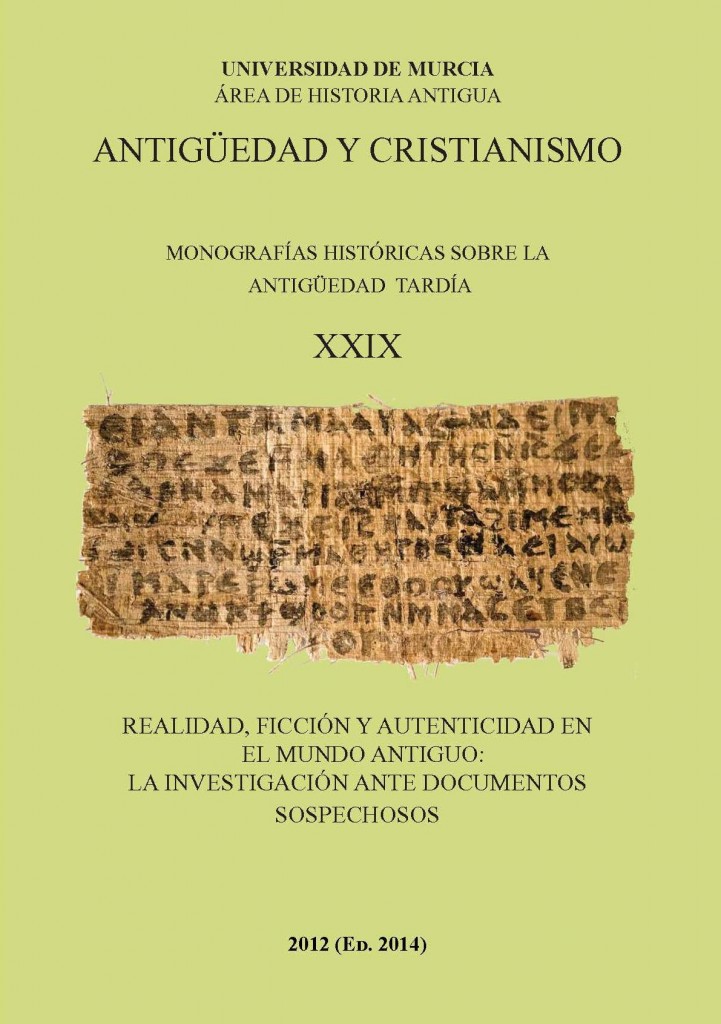The Preneste fibula and its diffusion in Spain. Historiography of Latin linguistics at the beginning of the 20th century
Abstract
Regardless of its authenticity or falsity, the Preneste fibula followed a process of study and, above all, of scientific and academic popularization in which F. Stolz and A. Ernout played a major role. This work addresses the study of this process of popularization and legitimization from a particular point of view, that of the transfer of knowledge of the fibula to the incipient study of the historical linguistics of Latin in Spain, during the first and second decades of the 20th century. As expected, the dissemination of the works of Stolz and Ernout contributed to this transfer. The present study of the historiography of linguistics will show us the process by which a given knowledge goes from being a novelty to being a received theory.
Downloads
-
Abstract423
-
PDF (Español (España))196
References
F. BÜCHELER, “Aelteste lateinische Inschrift”, Rheinisches Museum 42, 1887, pp. 317–320
F. BÜCHELER, “Altes Latein”, Rheinisches Museum 36, 1881, pp. 235–244
F. DÜMMLER, “Iscrizione della fi bula prenestina”, Mittheilungen des kaiserlich Deutschen archaeologisches Instituts. Roemische Abtheilung. Band II, 1887, pp. 40–43.
F. GARCÍA JURADO, “El nacimiento de la filología clásica en España. La Facultad de Filosofía y Letras de Madrid (1932-1936)”, Estudios clásicos 50, 2008, pp. 77–104
F. GARCÍA JURADO, “La fíbula de Preneste y el nacimiento de la lingüística histórica del latín”, en J. MARTÍNEZ (ed.), Mundus vult decipi. Estudios interdisciplinares sobre falsifi cación textual y literaria, Madrid 2012, pp. 127–136
F. GARCÍA JURADO, “Los primeros estudios sobre Latín cristiano y medieval en España y su relación con el Centro de Estudios Históricos: Pascual Galindo Romeo”, en Mª T. Callejas Berdonés et alii (eds.), Manipulus Studiorum en recuerdo de la profesora Ana Aldama Roy, Madrid 2014, pp. 425-435.
F. J. MIQUEL ROSELL, “La Analogía en la Morfología latina”, Revista de Archivos, Bibliotecas y Museos51, 1930
F. STOLZ, Geschichte der Lateinischen Sprahe, Leipzig 1910
F. STOLZ, Historia de la lengua latina. Trad. Américo Castro, Madrid 1922.
G. LIGNANA, “Sopra l’iscrizione della Fibula Prenestina (cf. sopra pag. 37–43). Lettera di G. Lignana a W. Helbig”, Mittheilungen des kaiserlich Deutschen archaeologisches Instituts. Roemische Abtheilung. Band II, 1887, pp. 139–140.
M. BRÉAL, “L’inscription de Duenos”, Mélanges d’archéologie et d’histoire 2, 1882, pp. 147–16
M. ESPAGNE, “Más allá del comparatismo. El método de las transferencias culturales”, Revista de Historiografía 6, 2007, pp. 4–13).
M. RODRÍGUEZ LOSADA, Gramática histórico-fi losófi ca de la lengua latina, Oviedo 1888.
Mª J. BARRIOS CASTRO, “La gramática griega”, en F. García Jurado et alii (eds.), La historia de la literatura grecolatina durante la Edad de Plata de la cultura española (1868-1936), Málaga 2010, pp. 137–156.
P. GALINDO, Literatura latina, Zaragoza 1928
P.U. GONZÁLEZ DE LA CALLE, “Introducción al estudio de la fonética latina”, en Varia. Notas y apuntes sobre temas de letras clásicas, Madrid 1916, pp. 7–154
V. GARCÍA DE DIEGO, Literatura latina y antología, Madrid 1927
W. HELBIG, “Sopra una fi bula d’oro trovata presso Palestrina”, Mitteilungen des kaiserlich Deutschen archaeologisches Instituts. Roemische Abtheilung. Band II, 1887, pp. 37–39.
W.S. TEUFFEL, Geschichte der Römische Litteratur, Leipzig 1870
1. The authors non-exclusively assign the exploitation rights (reproduction, distribution, communication and transformation) to the magazine.
2. The works published in this magazine are subject to the Attribution-ShareAlike 4.0 International license (CC By SA 4.0). Therefore, they can be copied, used, disseminated, transmitted and publicly displayed, provided that:
i) the authorship and the original source of its publication (journal, editorial and URL of the work) are cited, thus allowing its recognition.
ii) it is allowed to remix, transform or create from the material while maintaining the same license as the original.
Note: Articles prior to 2022 incorrectly display the CC by SA license in the abstract page. They are under a CC by NC ND license as embedded in the article pdfs. Articles published in 2022 and after are under the CC by SA license.

3. Self-archiving conditions. Authors are allowed and encouraged to electronically disseminate the pre-print (version before being evaluated) and/or post-print (version evaluated and accepted for publication) versions of their works before publication, as it favors their publication. Earlier circulation and diffusion and with it a possible increase in its citation and reach among the academic community. Color RoMEO: verde.
























